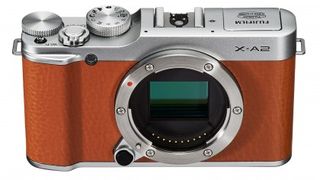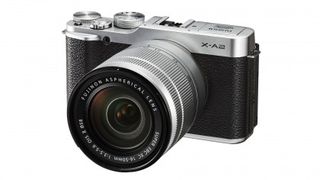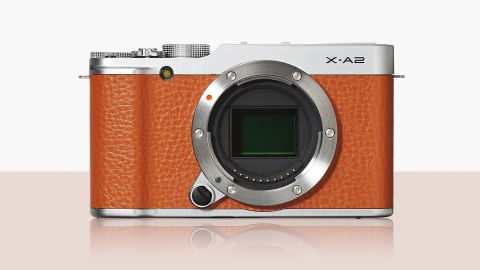TechRadar Verdict
A solid feeling entry-level interchangeable-lens camera which lacks a viewfinder, but that has enough other features to satisfy novices and enthusiasts on a budget. Image quality is also usually high.
Pros
- +
Overall image quality
- +
AF performance
- +
Classic Chrome film simulation
Cons
- -
No viewfinder
- -
No remote camera control via Wi-Fi
- -
Beaten for resolution by 24Mp rivals
Why you can trust TechRadar
Fujifilm's X-series of compact system cameras are one of the success stories of recent times. Their popularity seems to have taken even their manufacturer by surprise. A combination of retro styling, traditional controls, robust build and high image quality have made models like the Fuji X-T1, X-E2 and X-Pro1 very attractive to enthusiast photographers.
In a bid to cater for less experienced photographers Fuji also offers the X-M1 and the X-A1, which has now been replaced by the X-A2 tested here.
The X-M1 and X-A1 are identical apart from the fact that they use different sensors. The X-M1 has the same APS-C format X-Trans CMOS sensor as the Fuji X-Pro 1 and Fuji X-E1, while the X-A1 and now the X-A2 have a standard APS-C format CMOS sensor. This means that unlike other Fuji X-series cameras, the X-A cameras' sensor has a Bayer pattern primary colour filter and an anti-aliasing filter. Omitting the anti-aliasing or low-pass filter usually enables more detail to be recorded, but the differences are very minor in real world shooting conditions. The benefit of using a standard CMOS sensor is that the camera can be made cheaper.

Features
Many of the features of the X-A2 are the same as the X-A1's. For example, Fuji has plumped for the same 16.3Mp APS-C format (23.6mm x 15.6mm) sensor and the EXR Processor II image processing engine. This is is also the same engine as is used in the X-M1. It means that the sensitivity range of the X-A2 is the same as the X-A1, ISO200 to ISO6400 in the standard mode with JPEG-only expansions settings adding ISO 100, 12,800 and 25,600.
The maximum shooting rate is also unchanged at 5.6fps (frames per second) for up to 30 JPEG or 10 raw (or raw & JPEG) files.
Also as before, there's no viewfinder built-in and images must be composed on the screen on the back of the camera. This is still a 3-inch 921,000-dot device, but the range of its upward tilting movement has been increased to 175 degrees to make it easier to compose selfies. What's more, when the screen is tilted right up for viewing from in front of the camera, the X-A2 switches to using Face Detection and the new Eye Detection AF mode that is designed to focus on your eyes automatically.
Other new additions to the focusing system include Auto Macro AF and Multi-Target modes, aiming to make it easier for inexperienced photographers to get subjects sharp. The camera automatically switches to Auto Macro AF when close subjects are detected and in Multi-Target mode the camera uses multiple AF points to identify and focus on the subject.

Fuji sells the X-A2 with the new XC16-50mm F3.5-5.6 OIS II kit lens which has a closest focusing distance of 15cm (from the sensor) at its widest point. This means that it can focus on objects that are approximately 7cm from the front element at the shortest focal length.
Classic Chrome and other films
In line with other recent Fuji introductions and firmware upgrades, the X-A2 has the new Classic Chrome Film Simulation mode in addition to the previous collection; Provia (standard), Velvia (vivid), Astia (muted), Sepia and Black-and-White, which tailor the look of the JPEG images. These modes can be used when shooting raw files at the same time as JPEGs, so you can have a 'clean' file for post capture processing as well as the JPEG with the effect applied.
There's also a collection of Advanced Filter modes: Toy Camera, Miniature, Pop Colour, High Key, Low Key, Dynamic Tone, Soft Focus and several Partial Colour options. When these modes are selected the camera only records JPEG files, even if raw file recording has been previously set.
As well as the usual exposure compensation option (up to ±2EV/) it's also possible to bracket the Film Simulation mode, Dynamic Range mode or sensitivity setting. Raw file recording must be switched off before these options can be selected. Once activated, the camera creates three images (for example one with each of your three favorite Film Simulation modes applied) with a single press of the shutter release.
The X-A2 has Wi-Fi connectivity built-in and it's compatible with Fuji's Camera Application app, which enables its images to be browsed on the screen of a smartphone and wirelessly transferred. This app also enables location data gathered by the phone to be saved with images.
It's not possible to control the camera remotely via the app, but once the supplied PC AutoSave software is installed it's possible to transfer images wirelessly to a designated computer.

